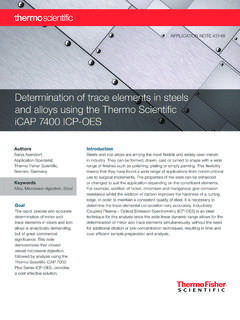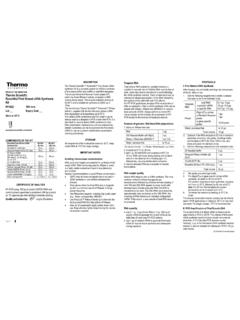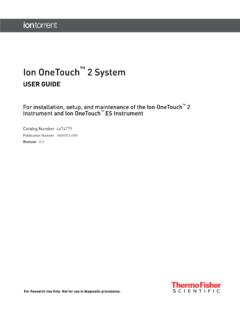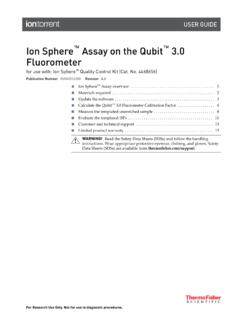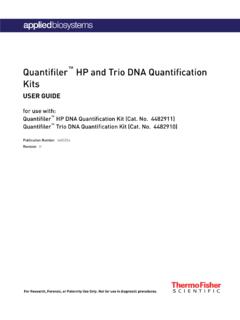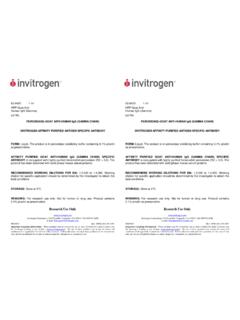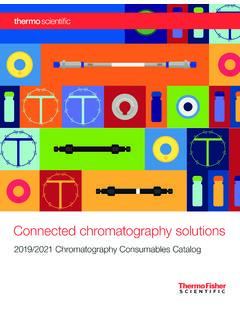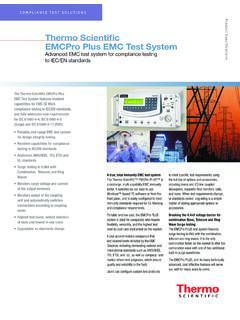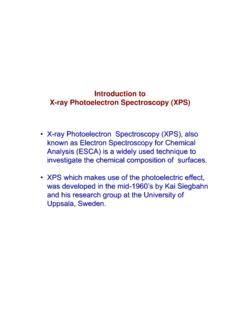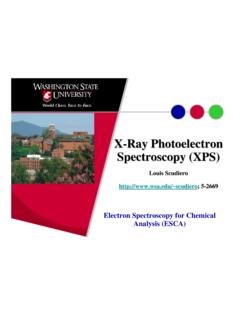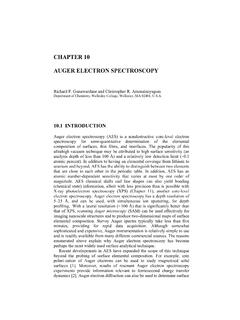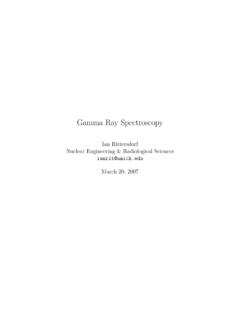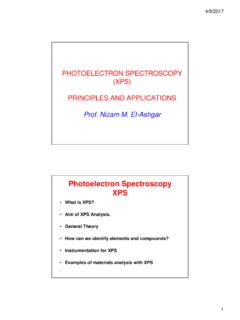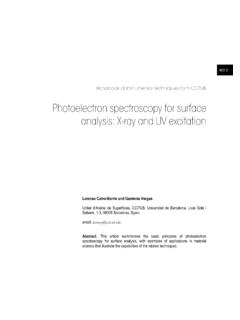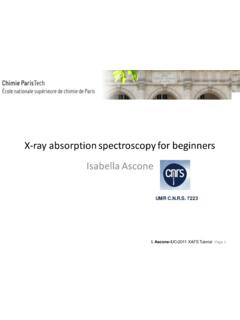Transcription of X-ray Photoelectron Spectroscopy
1 X-ray Photoelectron SpectroscopyEssential Knowledge BriefingsFirst Edition, 2016X-ray Photoelectron SPectroScoPy2 2016 John Wiley & Sons Ltd, The Atrium, Southern Gate, Chichester, West Sussex PO19 8SQ, UKMicroscopy EKB Series Editor: Dr Julian HeathSpectroscopy and Separations EKB Series Editor: Nick TaylorFront cover image: a sample in the ESCALAB Xi+ XPS microprobe. Image courtesy of Thermo Photoelectron SPectroScoPy3 About Essential Knowledge BriefingsEssential Knowledge Briefings, published by John Wiley & Sons, comprise a series of short guides to the latest techniques, appli cations and equipment used in analytical science.
2 Reviewed and updated annually, EKBs are an essential resource for scientists working in both academia and industry looking to update their understanding of key developments within each specialty. Free to download in a range of electronic formats, the EKB range is available at INTRODUCTION6 HISTORY AND BACKGROUND10 IN PRACTICE20 PROBLEMS AND SOLUTIONS24 WHAT S NEXT? X-ray Photoelectron SPectroScoPy4 INTRODUCTION To a non scientist, a surface is nothing special. It is merely a boundary a thin volume at the extremity of an object that marks that object s transition to the surrounding medium.
3 To many researchers, however, the surface of a solid object has a scientific importance that far exceeds its physical extent. Corrosion, wettability, catalytic activity, adhesiveness all these chemical properties and many more derive not from an object s bulk, but from the few uppermost atoms at its surface. X ray Photoelectron Spectroscopy (XPS) is one of the foremost tools for studying this surface chemistry. In its simplest form, XPS involves shining X rays onto a material to knock electrons from the surface atoms. By counting these ejected electrons and measuring their energy, it is possible to work out what elements are present on the surface and in what relative quantities.
4 Indeed, it is even possible to work out the electronic state of those atoms and how they are bonded, thereby revealing a surface s precise chemical composition. In the past 20 years or so that it has been a mature tech nique, XPS has been applied to the full breadth of surface chem istry, from problem solving in engineering to cutting edge scientific analysis. In this way, it has provided insights into a wide variety of subject matter, whether understanding the deterioration of a frying pan s non stick coating or fine tuning the design of a new semiconductor for solar cells.
5 In recent years, XPS has also demonstrated its crucial relevance to nascent fields of materials science by helping researchers investigate new two dimensional materials such as Photoelectron SPectroScoPy5 XPS spectrometers are not especially cheap compared with, say, electron microscopes, and therefore tend to be found in specialist facilities that offer surface analysis. But these facilities are now commonplace, and inexperienced users can rest assured that experts are usually on hand to provide advice. Even so, it can help newcomers to have some prior understanding of the tool.
6 This Essential Knowledge Briefing (EKB) aims to give a simple introduction to XPS. It will explore the history of the technique, how it works, and what it can be used for. It will also detail some of the specific implementations of XPS, discuss what practical problems can arise, and explore what developments are likely to be seen in the Photoelectron SPectroScoPy6 HISTORY AND BACKGROUND The basis of XPS is the photoelectric effect, a phenomenon first reported by German physicist Heinrich Hertz in 1887. Hertz found that a metal electrode illuminated with ultraviolet light sometimes emitted a spark.
7 This in itself was not a wholly mysteri ous observation, as classical physics stated that the light could simply be transferring its energy to the metal, generating an elec tric charge. But such classical reasoning predicted that the cut off for the effect should depend on the intensity of the light. In fact, subsequent experiments in particular those by German physicist Philipp Lenard suggested a different cut off criterion: the light s frequency. The explanation, courtesy of Albert Einstein 18 years later, was that light travels not in continuous waves but in discrete packets or quanta , each with energy proportional to frequency.
8 In the midst of these developments, German physicist Wilhelm R ntgen discovered X rays and British physicist JJ Thomson and colleagues identified electrons as the particles of electric charge. In 1907, Thomson s student, PD Innes, wanted to know whether the photoelectric effect arose because light some how disintegrated a metal s atoms or because light could directly knock electrons free. It was in his efforts to find out that Innes recorded the first primitive XPS spectra, by exposing a metal to X rays and recording the numbers of electrons arriving at photo graphic plates as a function of velocity.
9 Innes concluded, incorrectly, that atomic disintegration was behind the photoelectric effect. He was ignorant of Einstein s work, and this was before British physicist Ernest Rutherford and Danish physicist Niels Bohr came up with the planetary model of the atom as a dense nucleus orbited by electrons, which X-ray Photoelectron SPectroScoPy7happened between 1911 and 1913. In time, however, a visual picture emerged of the photoelectric effect, with individual photons provided they had sufficient energy able to knock electrons from their atomic orbitals.
10 The Rutherford Bohr model of the atom was still evolving by the 1920s, and XPS had the potential to play a practical role. An accurate knowledge of the energies associated with the different electronic orbits within the atoms is essential to the further development of the theory of atomic structure, wrote H Robin son, a former colleague of Rutherford s and an XPS pioneer. For XPS to become a refined analytical tool, however, science would have to wait three decades for the dedicated work of Swedish physicist Kai Siegbahn and colleagues. In 1954, Sieg bahn s group built the first high resolution system for XPS (which they preferred to call electron Spectroscopy for chemical analysis, or ESCA) and used it to record the spectrum of cleaved sodium chloride.
